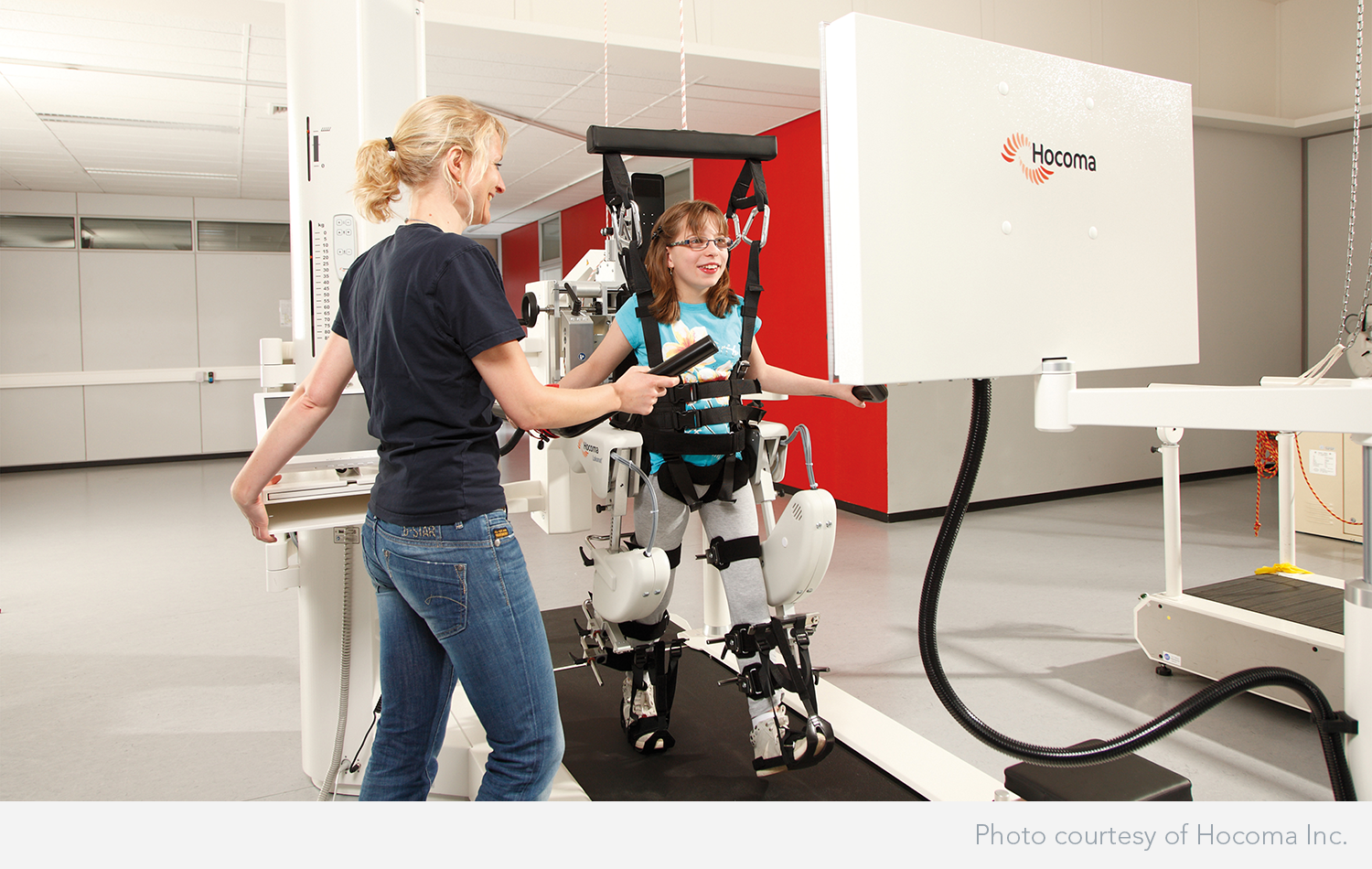Technology Platform
Platform Leader: Elaine Biddiss

The Technology platform encompasses technological innovations for improving the lives of children and youth with CP, including research into virtual reality therapies, innovations in augmentative communication for individuals with CP who are non-verbal, robotic and exoskeleton gait and upper limb training, and transcranial magnetic stimulation.
Virtual Reality Therapy for Children with CP (VRT)
Leaders: Elaine Biddiss & Darcy Fehlings
This project involves the development and testing of a low-cost, home-based virtual reality therapy program that capitalizes on children’s interest in video games and their ability to promote physiological change with increased feedback and motivation through repetitive play and increasing complexity of tasks. More specifically, children will be rewarded for using their hemiplegic hand when playing video games. Wrist movements will be motion-captured in order to facilitate fine motor rehabilitation. Games can be adapted to each child’s abilities and rehabilitative needs, and come with online tracking and feedback modules. The system will include an extensive library of video games to encourage and retain participation. Testing of this system will be conducted simultaneously to development, in partnership with children and their families.
For more information, please contact Ajmal Khan
Orofacial Communication Technology
Leader: Tom Chau
Access to communication is limited for non-verbal children and youth with CP. Orofacial gestures (using tongue, mouth) can be incorporated into technologies for communication. This project aims to develop a user-independent system that can reliably detect a wide variety of orofacial gestures by using different types of sensors and investigating motion cues, thermal cues and a facial analysis. In addition, the impact of access technology on communication skill levels and participation in social and non-academic school activities will be measured.
For more information, please contact Fanny Hotze
Exergame Technology for Youth with CP
Leaders: Darcy Fehlings & Nicholas Graham
Adolescents with CP are less physically active when compared with their typically-developing peers. Youth with CP who use mobility aids may experience a decline in function as they enter their adolescent years and in some cases move from walkers to wheelchairs. In addition, even when active, youth with CP tend to participate in more solitary activities. Exergames are multi-player exercise video games that can be used to promote physical activity and social interaction for youth with CP. This project aims to determine if a home-based exergame intervention can provide fitness and social benefits to adolescents with CP (GMFCS level I, II and III), and typically-developing peers of the same age.
For more information, please contact Lauren Switzer
Related Resources
Designing Action-based Exergames for Children with Cerebral Palsy
Julia Hanes and Hamilton Hernandez, 2015
Repetitive Transcranial Magnetic Stimulation (rTMS)
Leaders: Gabrielle deVeber, Robert Chen & Darcy Fehlings
It has been hypothesized that serial inhibitory, low-frequency rTMS can produce improvements in motor function of the impaired arm in hemiplegic CP children with stroke. A previous study has shown that rTMS-treated children demonstrated significant improvements in hand-grip strength and hand motor function. This current study attempts to evaluate whether the type of brain injury impacts on the effectiveness of TMS.
For more information, please contact Regina Cerys Starkey
Robotics
Robotic Gait Training (Lokomat)
Leaders: Virginia Wright, Margot Taylor & Darcy Fehlings
The Pediatric Lokomat gait trainer is a robotic therapy aimed at improving walking and gross motor function in children with CP. This project will evaluate if robotic therapy can lead to neuroplastic changes in the brain and improve clinical gross motor or gait outcomes. This project will add a functional magnetic resonance imaging (fMRI) component in order to:
- identify changes in brain activation patterns after robotic gait training with the Lokomat;
- evaluate how changes to the organization of the brain can impact motor and functional outcomes; and
- investigate whether specific brain activation patterns can predict a ‘successful’ gross motor and gait pattern.
This information can then be used to create innovative therapies for children with CP.
For more information, please contact Alicia Hilderley
Robotic Proprioception Measurement (Kinarm)
Leaders: Lucie Pelland & Stephen Scott
Team Member: Dawa Samdup
This project aims to use robotic technology, in the form of the Kinarm Exoskeleton Robot, to measure proprioceptive function (figuring out where the body part is in space) in children with hemiplegic CP, when compared with typically developing children (5 to 18 years of age). The measurement of proprioceptive function is an important clinical objective for the evaluation and treatment of children with hemiplegic CP.
For more information, please contact Lucie Pelland
Gait Enable (robotic walker for children with CP)
Leader: Anna McCormick & GaitTronics Inc.
Individuals with CP who function at the GMFCS IV level use a wheelchair for mobility and a walker when moving around hands-free.GaitTronics, an Ottawa based company, has developed a gait trainer (Gait Enable) to assist individuals when they walk, to help lift individuals from a sitting position and prevent falls. The aim of this project is to develop a GaitEnable mobile rehabilitation prototype that will meet the needs of youth with CP. More specifically, we will assess whether this prototype will promote and facilitate safe foot placement and prevent gait scissoring.
For more information, please contact Hana Alazem
